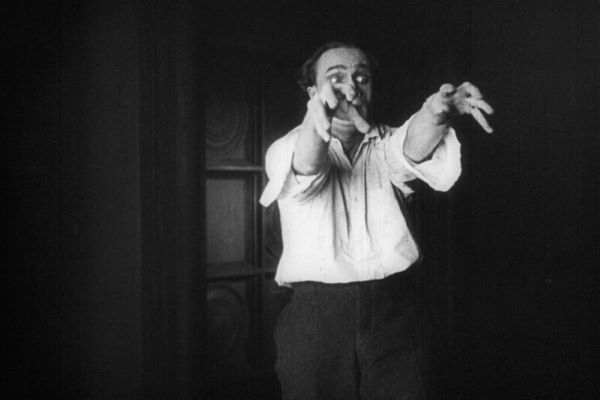The Hands of Orlac reunited the director and star of the seminal The Cabinet of Dr. Caligari, Robert Weine and Conrad Veidt, in an operatic mystery that may be the first filmed instance of the ‘transplant’ or ‘possessed body part trope’ that has endured in the subsequent century; from the English-language remake Mad Love with Peter Lorre in 1935, to Bruce Campbell‘s Keaton-like slapstick battle with his own hand ended in Evil Dead II. A rather strange ending strips it much of its intrigue, meaning it remains in the shadow of its legendary predecessor. But, with a typically tortured and dynamic performance from Veidt, and customarily moody atmosphere and set design, this remains a memorable and deceptively ambiguous silent treat.
Famous concert pianist Paul Orlac (Veidt) suffers horrible injuries to his hands in a train crash. Informed that his hands will be amputated, his wife Yvonne (Alexandra Sorina) pleads with a surgeon to save them, since they are his life (and, it’s implied, they hold an erotic fascination for her). Orlac awakens from his surgery to find out that the hands he now sees belong to an executed murderer named Vasseur. Paul is horrified, and vows never to touch another person or perform ever again. This throws his relationship with Yvonne and his finances into a downward spiral, as well as his mental state.
What is most notable in The Hands of Orlac is the relatively normal set design. Compared to the freakish abstraction of Caligari, Orlac exists in a more realistic (albeit gloomy) environment. The celebrated angularity of German expressionism is used sparingly, most impressively in the genuinely horrendous aftermath of the train wreck; all twisted metal and billowing smoke – a truly hellish spectacle, spectacularly rendered. Veidt remains one of the finest silent performers. He manages to find some depth in a fairly unknowable and underwritten role, evincing the dismay at his body that David Cronenberg would later push to more extreme ends. This is undoubtedly an embryonic depiction of body horror.
Strangely. the story seems to take at face value the narrative that Paul has lost his hands and had Vasseur’s grafted on. When he first sees his new hands, Paul expresses horror, but at the thought of never being able to play the piano again. His shock isn’t that of a man who doesn’t recognise the appendages. Later, when he thrusts at the air with Vasseur’s dagger, apparently in some kind of trance, there is no scarring on his wrists. There may be a rarely acknowledged possibility that the fracture to his skull has caused a form of somatoparaphrenia, the belief that a limb does not belong to them. This delusion is then exacerbated by the letters received from the blackmailers. It could also be a result of PTSD from the train crash. Charles Dickens was famously so traumatised by his involvement in the Staplehurst rail crash in 1865, that the hitherto prolific author never finished another novel before his death in 1870.
This ambiguity actually succeeds in papering over some of the coincidence and outright contrivances in its crazy finale, involving blackmail, mind control and a pair of rubber gloves. What audiences made of it at the time is anyone’s guess. There’s a lack of the storytelling elegance that characterised much of the best silent films, spinning their yarns visually out of necessity. Even Caligari‘s rug pull makes sense. As such, Weine sets up a compelling mystery and then guts it with absurdity. It remains enjoyable however, particularly at a streamlined 93 minutes, reduced from the more ponderous 110 minutes of the original cut (also present, with a new score). Veidt remains one of the more charismatic actors of the time, and there’s a particularly brilliant example of swooning from Alexandra Sorina that is among the best of the entire era; one rich in fainting damsels.
Available on Blu-ray from Mon 14 Jun 2021
